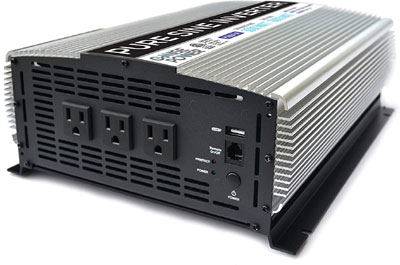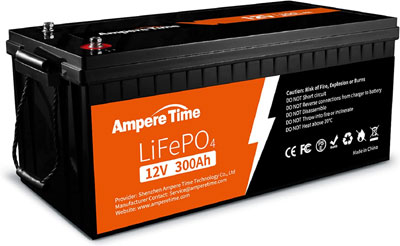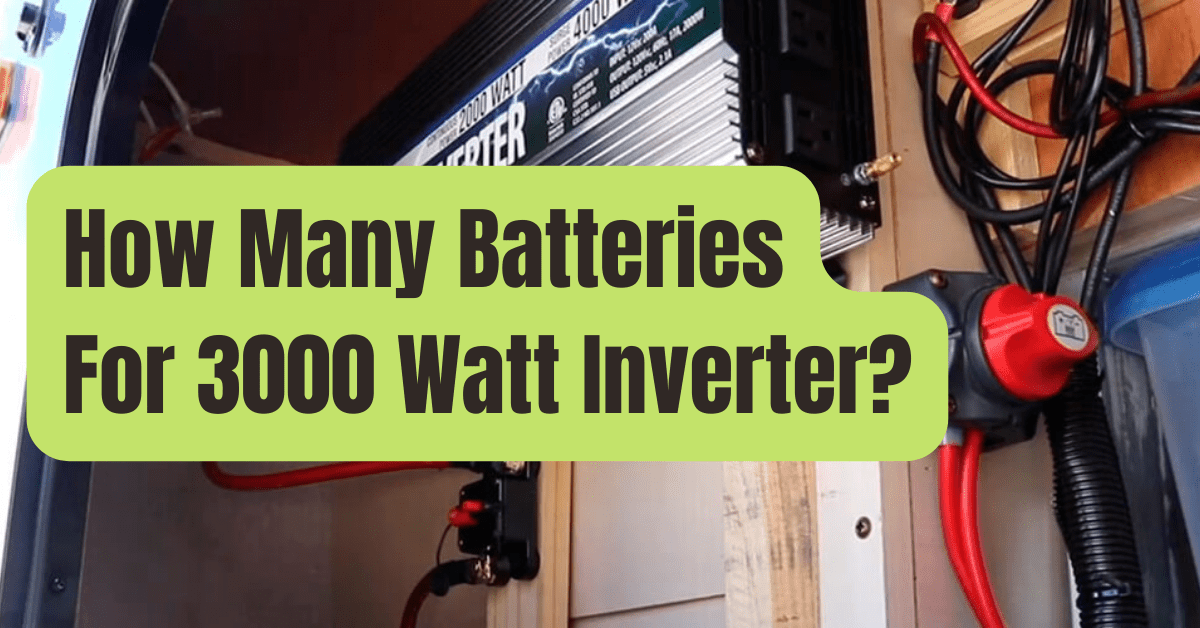A highly common kind of power inverters utilized in emergency situations, camping, off-grid applications, medical and security systems, and similar applications is the 3000-watt power inverter.
The majority of 3000-watt power inverters are fairly easy to operate, however problems with runtime and dependability might arise when sizing the necessary batteries or battery packs.

Energy and Power Requirements for 3000 Watt Power Inverters
Power inverters are not perfect devices and experience some energy loss when converting energy.
Although there are units with superior energy efficiency, such units are often more costly ones, good power inverters have an energy efficiency of around 85%.
As a result, assuming the power inverter has a 3000 Watt continuous output, the necessary battery power is:
PBat = PInv / Energy Efficiency % = 3000 Watt / 0.85 = 3530 Watts
Additionally, as power inverters often have a surge output power that is two times as much as the continuous output power, the battery must provide substantially more power for a very little period of time (typically only a few seconds):
PBat = PInt / Energy Efficiency % = 6000 Watt / 0.85 = 7060 Watts
Therefore, the battery (or battery pack) has to be able to provide 3600 watts constantly and 7200 surge watts in order to power a 3000 Watt power inverter with an energy efficiency of 85%.
This addresses the issue of power.
But what about the need for energy?

Power inverters often don’t run continuously at full capacity; if they do, the device is significantly underpowered.
Energy needs are often specified as continuous power for a certain period of time, such as 1000W for 3 hours.
In such instance, the battery’s required energy is determined using the following formulas:
PBat = 1000 W / 0.85 W = 1200 W
EBat = PBat * T (h) = 1200 Watt * 3 hours = 3600 Wh = 3.6 kWh
In this scenario, a battery that can provide 3600 Watts constantly, 7200 surge Watts, and at least 3.6 kWh of energy is required to power a 3000 Watt power inverter with a surge power of 6000 Watt and an energy efficiency of 85%.
There are 3000 Watt power inverters that take 24V, 36V, or even 48V in addition to the more common 12V devices.
Calculating battery currents is simple:
IBatCont = P(W) / U(V) = 3600W / 12V = 300 Amps
IBatSurge = P(W) / U(V) = 7200W / 12V = 600 Amps
IBatAverage = P(W) / U(V) = 1200W / 12V = 100 Amps
Note: Currents are rather significant when powering 3000W inverters with 12V batteries.
The following formula may be used to determine the real capacity of a battery:
Actual Capacity = Required Energy (Wh) / U(V) = 3600 Wh / 12V = 300 Ah
Actual Capacity vs. Nominal Capacity: A battery’s nominal capacity is the amount of energy it can hold after being depleted for 20 hours.
The real capacity of a battery, particularly a lead-acid battery, diminishes as it is depleted more quickly; with lead-acid batteries, the actual capacity after 1 hour might be as low as 50–70% of the nominal capacity after 20 hours.
Lithium deep discharge batteries are less susceptible to capacity loss due to discharge current, however if a particular current is achieved, the lithium battery is disconnected by the integrated Battery Management System (BMS) to prevent overcurrent discharge.
Personally, I believe that lithium batteries are much superior than lead-acid batteries for the majority of applications; for more information on these batteries, feel free to read our post on the Best 12V, 24V, 36V, and 48V Lithium Deep Cycle Battery For a Power Inverter.

One of the top batteries in its class, the Ampere Time 12V 300Ah battery, for instance, supports:
- 200 Amps maximum continuous current;
- A maximum 5 second surge current of 400 Amps,
- The joining of four batteries in parallel and four batteries in series to make bigger battery packs.
In our example, we would want at least two of these batteries linked in parallel to power a 3000W power inverter.
This kind of battery pack would support:
- Maximum continuous current of 400 Amps, which exceeds the necessary 300 Amps,
- A maximum surge current of 800 Amps for 5 seconds, which exceeds the necessary 600 Amps,
- The actual capacity, which is 600 Ah rather than the needed 300 Ah,
If the battery pack is too big, keep in mind that Ampere Time 12V 200Ah battery has the same current constraints but offers a capacity of 400 Ah when two batteries are linked in parallel.
This capacity is still more than adequate for our scenario.
Of course, there are further 12V lithium batteries that can run 3000W and comparable power inverters, such as the following:
| Model | Battery Type Chemistry | Group Size Capacity (Ah) | Discharge Currents | Parallel / Series Connections | Weight (lbs/kg) |
| Aicipow PDAC-12100 | Deep Cycle LiFePO4 | 31 100 | 100A cont. | P: up to 4 S: up to 4 | 26 lbs; 11.8 kg |
| Aicipow PDAC-12200 | Deep Cycle LiFePO4 | 4D (6D) 200 | 100A cont. | P: up to 4 S: up to 4 | 58 lbs; 26.3 kg |
| AIMS Power LFP12V50A | Deep Cycle LiFePO4 | – 50 | 50A cont. 100A 10s | ? | 17.75 lbs; 8.04 kg |
| AIMS Power LFP12V100A | Deep Cycle LiFePO4 | 31 100 | 100A cont. 200A 10s | ? | 30.2 lbs; 13.7 kg |
| AIMS Power LFP12V200A | Deep Cycle LiFePO4 | 4D (6D) 200 | 160A cont. 350A 10s | ? | 77 lbs; 34.9 kg |
| AIMS Power LFP12V50B | Deep Cycle LiFePO4 | – 50 | 50A cont. 100A 10s | P: up to 4 S: up to 4 | 15.5 lbs; 7.0 kg |
| AIMS Power LFP12V100B | Deep Cycle LiFePO4 | 31 100 | 100A cont. 200A 10s | P: up to 4 S: up to 4 | 28.5 lbs; 12.9 kg |
| AIMS Power LFP12V200B | Deep Cycle LiFePO4 | 4D (6D) 200 | 200A cont. 400A 10s | P: up to 4 S: up to 4 | 62 lbs; 28.1 kg |
| Ampere 12V 50Ah Plus | Deep Cycle LiFePO4 | – 50 | 50A cont. 100A 5s | P: no limits (4?) S: up to 4 | 14.3 lbs; 6.5 kg |
| Ampere 12V 100Ah | Deep Cycle LiFePO4 | 31 100 | 100A cont. 280A 5s | P: up to 4 S: up to 4 | 24.25 lbs; 11 kg |
| Ampere 12V 200Ah Plus | Deep Cycle LiFePO4 | 4D (6D) 200 | 200A cont. 400A 5s | P: up to 4 S: up to 4 | 52.3 lbs; 23.7 kg |
| Ampere 12V 300Ah Plus | Deep Cycle LiFePO4 | 4D (8D) 300 | 200A cont. 400A 5s | P: up to 4 S: up to 4 | 63 lbs; 28.54 kg |
| Ampere 12V 400Ah Plus | Deep Cycle LiFePO4 | 8D 400 | 250A cont. 750A 5s | P: up to 4 S: up to 4 | 86.2 lbs; 39.1 kg |
| Banshee LFP-31M | Dual Purpose LiFePO4 | 31 100 | 1200 CCA | P: ? S: up to 4 | 24.2 lbs; 11 kg |
| Battle Born BB5012 | Deep Cycle LiFePO4 | – 50 | 60A cont. 100A 30s | P: yes S: up to 4 | 17.6 lbs; ~8.0 kg |
| Battle Born BB10012 | Deep Cycle LiFePO4 | 31 100 | 100A cont. 200A 30s | P: yes S: up to 4 | 29 lbs; 13.2 kg |
| Battle Born BBGC2 | Deep Cycle LiFePO4 | GC2 100 | 100A cont. 200A 30s | P: yes S: up to 4 | 31 lbs; 14 kg |
| Bioenno Power BLF-12100WS | Deep Cycle LiFePO4 | 31 100 | 100A cont. 200A 5s | (not recommended) | 28.1 lbs; 12.8 kg |
| Chins 12V50Ah | Deep Cycle LiFePO4 | – 50 | 50A cont. 150A 5s | P: up to 4 S: up to 4 | 13.8 lbs; 6.3 kg |
| Chins 12V100Ah | Deep Cycle LiFePO4 | 31 100 | 100A cont. 300A 5s. | P: up to 4 S: up to 4 | 23.9 lbs; 10.8 kg |
| Chins 12V200Ah | Deep Cycle LiFePO4 | 4D (6D) 200 | 200A cont. 600A 5s | P: up to 4 S: up to 4 | 49.4 lbs; 22.4 kg |
| Chins 12V300Ah | Deep Cycle LiFePO4 | 4D (6D) 300 | 200A cont. 600A 5s | P: up to 4 S: up to 4 | 67.3 lbs; 30.5 kg |
| Chins 12V400Ah | Deep Cycle LiFePO4 | 4D (6D) 400 | 250A cont. 750A 5s | P: up to 4 S: up to 4 | 86.4 lbs; 39.2 kg |
| Eastup 1250750 | Dual Purpose LiFePO4 | 34R/97R 50 | 750 CCA 930 MCA | ? | 15.43 lbs; ~7.0 kg |
| Eastup 12751000 | Dual Purpose LiFePO4 | 94R 75 | 1000 CCA | ? | 18.5 lbs; 8.4 kg |
| Eco-Worthy 12V50Ah | Deep Cycle LiFePO4 | – 50 | 60A cont. | P: unlimited S: up to 4 | 11.9 lbs; 5.4 kg |
| Eco-Worthy 12V100Ah | Deep Cycle LiFePO4 | 34 100 | – | P: up to 4 S: up to 4 | 23 lbs; 10.4 kg |
| Eco-Worthy 12V150Ah | Deep Cycle LiFePO4 | 31 150 | 150A cont. | P: unlimited S: up to 4 | 36.7 lbs; 16.6 kg |
| Eco-Worthy 12V200Ah | Deep Cycle LiFePO4 | – 200 | 120A cont. | P: unlimited S: up to 4 | 52.9 lbs; 24 kg |
| ExpertPower EP1250 | Deep Cycle LiFePO4 | – 50 | 50A cont. 100A 10s | ? | 13 lbs; 5.9 kg |
| ExpertPower EP12100 | Deep Cycle LiFePO4 | 31 100 | 100A cont. 200A 2s | ? | 22.6 lbs; 10.3 kg |
| ExpertPower EP12200 | Deep Cycle LiFePO4 | 4D (6D) 200 | 150A cont. 200A 3s | ? | 48.3 lbs; 21.9 kg |
| GLI GLIBATT12050 | Deep Cycle LiFePO4 | 26 50 | 50A cont. 500A 5s(?) | P: yes S: up to 4 | 12 pounds; 5.5 kg |
| GreenLiFE GL50-50AH | Deep Cycle LiFePO4 | 21 50 | 50A cont. | Yes | 15 lbs; 6.8 kg |
| GreenLiFE GL80-80AH | Deep Cycle LiFePO4 | 27 80 | 80A cont. | Yes | 28 lbs; 12.8 kg |
| GreenLiFE GL100-100AH | Deep Cycle LiFePO4 | 31 100 | 100A cont. 1000A 5s | Yes | 31 lbs; 14 kg |
| GreenLiFE GL260-260AH | Deep Cycle LiFePO4 | 8D 260 | 100A cont. 2600A 5A | Yes | 80 lbs; 36.24 kg |
| JITA 12V100Ah | Deep Cycle LiFePO4 | 31 100 | 100A cont. | P: up to 4 S: up to 4 | 23.8 lbs; 10.8 kg |
| JITA 12V200Ah | Deep Cycle LiFePO4 | 4D (6D) 200 | 200A cont. | P: up to 4 S: up to 4 | 48.9 lbs; 22.2 kg |
| JITA 12V300Ah | Deep Cycle LiFePO4 | 4D (6D) 300 | 200A cont. | P: up to 4 S: up to 4 | 59.5 lbs; 27 kg |
| JITA 12V400Ah | Deep Cycle LiFePO4 | 4D(6D) 400 | 200A cont. 400A 5s | P: up to 4 S: up to 4 | 83.7 lbs; 37.9 kg |
| Kunmo LF-12100 | Deep Cycle LiFePO4 | 75 100 | 100A cont. | ? | 25.3 lbs; 11.5 kg |
| Lossigy 12V100Ah | Deep Cycle LiFePO4 | – 100 | 50A cont. | P: up to 10 S: up to 4 | 23.8 lbs; 10.8 kg |
| Lossigy 12V200Ah | Deep Cycle LiFePO4 | 4D 200 | 100A cont. | P: no limit (10?) S: up to 4 | 46 lbs; 20.9 kg |
| Lossigy 12V300Ah | Deep Cycle LiFePO4 | 4D (6D) 300 | 200A cont. | P: up to 10 S: up to 4 | 72 lbs; 32.6 kg |
| Lossigy 12V400Ah | Deep Cycle LiFePO4 | 4D (6D) 400 | 200A cont. | P: up to 10 S: up to 4 | 95 lbs; 43 kg |
| Mighty Max ML100-12LI | Deep Cycle LiFePO4 | 30H 100 | 100A cont. 200A 15s | P: up to 4 S: not allowed | 29.54 lbs; 13.4 kg |
| Mighty Max ML4D-LI | Deep Cycle LiFePO4 | 4D (6D) 200 | – | P: up to 4 S: not allowed | 48 lbs; 21.8 kg |
| PacPow 12V 100Ah | Deep Cycle LiFePO4 | 31 100 | 100A cont. 300A 10s | P: up to 4 S: up to 4 | 27.56 lbs; 12.5 kg |
| Pionergy 12V200Ah | Deep Cycle LiFePO4 | 4D (6D) 200 | 200A cont. | P: up to 4 S: up to 4 | 46.1 lbs; 20.9 kg |
| Pionergy 12V300Ah | Deep Cycle LiFePO4 | 4D (6D) 300 | 200A cont. | P: up to 2 S: up to 4 | 71.2 lbs; 32.3 kg |
| Power Queen 12V100Ah | Deep Cycle LiFePO4 | 31 100 | 100A cont. | P: up to 4 S: up to 4 | 25.25 lbs; 11.0 kg |
| Power Queen 12V200Ah | Deep Cycle LiFePO4 | 4D (6D) 200 | 100A cont. | P: up to 4 S: up to 4 | 48.28 lbs; 21.9 kg |
| Power Queen 12V300Ah | Deep Cycle LiFePO4 | 4D (6D) 300 | 200A cont. | P: up to 4 S: up to 4 | 62.8 lbs; 28.5 kg |
| Renogy RNG-BATT-LFP-12-50 | Deep Cycle LiFePO4 | – 50 | 50A cont. | P: yes S: not allowed | 14.77 lbs; 6.7 kg |
| Renogy RBT100LFP12S-G1 | Deep Cycle LiFePO4 | – 100 | 100A cont. | P: yes S: not allowed | 26 lbs; 11.8 kg |
| Renogy RNG-BATT-LFP-12-170 | Deep Cycle LiFePO4 | – 170 | 125A cont. | ? | 46.3 lbs; 20.97 kg |
| Scream Power 12V100Ah | Deep Cycle LiFePO4 | 31 100 | ? | P: ? S: no | 24.3 lbs; 11 kg |
| Scream Power 12V400Ah | Deep Cycle LiFePO4 | – 400 | 400A cont. 800A peak | ? | 81.4 lbs; 36.9 kg |
| Vatrer 12C 100Ah | Deep Cycle LiFePO4 | 31 100 | 100A cont. | P: up to 4 S: up to 4 | 33 lbs; 15 kg |
| Vatrer 12V 200Ah | Deep Cycle LiFePO4 | 4D 200 | 100A cont. | P: up to 4 S: up to 4 | 48.5 lbs; 22 kg |
| VMAXTANKS LF27-12100 | Deep Cycle LiFePO4 | 27 100 | 125A cont. 350A 3s | P: up to 4 S: up to 4 | 25.3 lbs; 11.5 kg |
| VMAXTANKS LFPU1-1245 | Deep Cycle LiFePO4 | U1 45 | 45A cont. 100A 3s | P: up to 4 S: up to 4 | 10.8 lbs; 4.9 kg |
| VMAXTANKS VPG12C-50Li | Deep Cycle LiFePO4 | U1 50 | 50A cont. 100A 5s 150A 3s | P: up to 2 S: not allowed | 12 lbs; 5.5 kg |
| Waterblade LFP 100-12.8 | Deep Cycle LiFePO4 | – 100 | 80A cont. 400A 1s | ? | 29 lbs; 13.2 kg |
| Weize FPLI-12100AH | Deep Cycle LiFePO4 | 31 100 | 50A cont. 100A 3s | P: up to 4 S: up to 4 | 26.4 lbs; 12.0 kg |
| Weize TPLI-12200AH | Deep Cycle LiFePO4 | 4D (6D) 200 | 100A cont. 200A 3s | P: up to 4 S: up to 4 | 27.6(?) lbs; 12.5(?) kg |
| Wingda W100-12V100AH | Deep Cycle LiFePO4 | 31 100 | 50A cont. | P: up to 4 S: up to 4 | 23.8 lbs; 10.8 kg |
| Wingda W200-12V200AH | Deep Cycle LiFePO4 | 4D (6D) 200 | 100A cont. | P: up to 4 S: up to 4 | 48.9 lbs; 22.15 kg |
| Wingda W300-12V300AH | Deep Cycle LiFePO4 | 8D 300 | 200A cont. | P: up to 4 S: up to 4 | 70.54 lbs; 31.95 kg |
| Zooms 12V 100Ah | Deep Cycle LiFePO4 | 31 100 | 100A cont. | P: up to 4 S: up to 4 | 25.35 lbs; 11.5 kg |
| Zooms 12V 200Ah | Deep Cycle LiFePO4 | 4D (6D) 200 | 200A cont. | P: up to 4 S: up to 4 | 49.6 lbs; 22.5 kg |
| Zooms 12V 300Ah | Deep Cycle LiFePO4 | 4D (6D) 300 | 200A cont. | P: up to 4 S: up to 4 | 62.83 lbs; 28.5 kg |

It is a good idea to over-dimension the battery pack when figuring out how many batteries are needed to power a 3000 Watt power converter since, in most cases, energy needs can only increase.
And whatever You do, remain careful.
Although these devices are simple to operate and keep up, they are not toys and may deliver strong currents that can cause severe harm, accidents, or worse.










